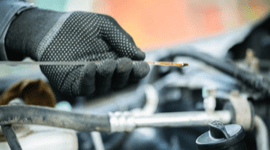EVOLVING ENGINE TECHNOLOGY DRIVING CHANGE
Over the years, automobiles have steadily evolved for the better. Notably, hi-tech electronics like smart sensors, mobile connectivity, assisted driving features, and the rest have made driving more comfortable and safer. But, the most exciting improvements have taken place out of sight.
Engine technology is rapidly getting better because of 3 reasons:
1. Governmental and market pressure to reduce carbon emissions.
2. Increase in demand for engines that consume less fuel.
3. The need for speed while not compromising on the first two criteria.
By 2025, U.S. federal mandates call for a Corporate Average Fuel Efficiency (CAFE) of 54.5 miles per gallon. That doesn’t mean every car has to meet that standard, but that every manufacturer must meet that as an average across their entire fleet, which may span a range of vehicles from large SUVs and pickups to small hybrids and electric cars. (For comparison, the average today is 35.5 mpg.)
These efforts are directed towards improving the environment and promote eco-friendly vehicles, while offering the consumers a better idea of their vehicle’s fuel efficiency.
An important caveat here is that not every car needs to meet this standard—the manufacturer must see that their fleet, which most likely includes large SUVs, pickups, hybrids and electric vehicles, has the mandated fuel efficiency average. Currently, 35.5 miles per gallon is the standard.
Stringent fuel economy requirements have been the prime mover for newer engine technologies like:
- Gasoline Direct Injection (GDI) - GDI provides two advantages—performance and fuel efficiency—by directly injecting fuel into the combustion chambers at high pressure.
- Turbochargers – Turbocharged engines were exclusively used in racing and high-performance sports cars, but now, they are making their way into the everyday use passenger segment. Turbo engines provide more power by forcing the extra compressed air into the combustion chamber which gives an extra power boost. As of 2015, 21% of new vehicles had turbocharged engines, and the number is expected to jump to 80% by 2025.
- Downsizing – The latest compact cars have engines as small as one litre to reduce mass and weight. The size reduction automatically translates into better fuel efficiency. The technology has advanced to the point that even smaller engines don’t need to sacrifice horsepower. As a reference, today’s six-cylinder engines produce as much power as eight-cylinder engines from the previous generation, and the current four-cylinder engines outperform yesteryear’s six-cylinder counterparts.
The evolution of newer engine technologies has not always been a smooth ride. Fuel-efficient engines that don’t compromise on power encounter a phenomenon called LSPI (low-speed pre-ignition). This unwanted and uncontrolled event can cause severe damage to the engine over time. LSPI is a severe issue and has resulted in many warranty claims. To resolve the unwelcome side-effect, automakers globally are working with institutions like the American Petroleum Institute and major lubricant producers, including Caltex Lubricants.
The diagnosis is that combining many advancements into a single package causes incredibly high stresses inside the engine and better engine oils are the need of the hour. Advanced engine oils can protect all parts of a small, turbocharged, GDI engine that runs hotter, experience more stress, and has a high power density. That is why OEMs have started using synthetic oils of ever-thinner viscosities because they reduce friction and protect the engine.

About Author
Dave has over a decade of lubricants experience in Research, Product Development, and technical workshop training. He has a passion for science, and Dave has held various technical positions as a scientist from Greases to Passenger Car and Motorcycle Engine Oils. He loves to talk oils and science, and has been involved in several training workshops giving reason to why people should be excited and care about oils and additives. He’s currently the Consumer Brand Technical and OEM Manager where he’ll be developing the Havoline Engine Oils and Aftermarket Fuel Additives product strategy for the globe. Dave will interface with technology, business colleagues, and customers in support of Consumer Brands. Dave has a Ph. D. in Chemistry, Patents on lubricant composition and manufacture, and extensive engine oil formulation experience.
ARTICLES FOR YOU
ARTICLES FOR YOU

Synthetic Oils Are The Wave Of The Future For Passenger Cars

How Synthetic Oils Are Helping Cars Last Longer

GM’s dexos1™ PCMO Specification Knowledge

Base Oil Basics: Quality Starts At The Base
Need more assistance?
Begin your journey towards world class products and services with Caltex.

















